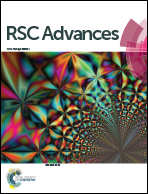Effective parameters on conductivity of mineralized carbon nanofibers: an investigation using artificial neural networks†
Abstract
The aim of this study was to predict the effects of different parameters on the conductivity of mineralized PAN-based carbon nanofibers by the artificial neural network (ANN) method. The conductivity of CNFs was investigated as a function of various parameters, including simulated body fluid (SBF) concentration, immersion time and CNFs diameter. In order to conduct ANN modeling, the considered parameters and experimental outputs were categorized into (i) training, (ii) validating and (iii) testing datasets, which were subsequently analyzed using three different training algorithms, including scaled conjugate gradient, Bayesian regularization, and Levenberg–Marquardt back-propagation. The comparison study between three artificial neural network models indicates that all back-propagation methods could be employed to estimate the cathodic current accurately. The results of cyclic voltammetry demonstrated that the cathodic current increased as a function of decreasing simulated body fluid concentration, immersion time and carbon nanofiber diameter. The Pearson correlation coefficients were significant at less than the 0.01% level for all prediction models. Among the studied algorithms, the scaled conjugate gradient back-propagation method produced the highest R-value at 0.92. Based on the promising results of the current approach, the mineralized CNFs can be tailored in a way to construct electro-conductive scaffolds capable of manipulating the activities of bone cells through electrical stimulation and could be utilized in bone tissue engineering.



 Please wait while we load your content...
Please wait while we load your content...